|
|
| | |
Chances and risks
The advantage for the user, his requirements and demands, and with it the economic efficiency of the products,
has to become the decisive factor of getting into the market with the processes and products.
The three main uses and their described ways of deployment lead to profits before long after the forward run
phase - and the potential of this technology is not yet exhausted.
That will be reached just with the projects of use. However it is a long and busy way up to this, because attitudes
have to be changed, people, firms and public authorities have to be convinced.
The work will be successful, because by getting into the market with the main products the conditions can be made
to develop the products, their image and their ways of deployment for the different described projects. Than the
way to an extensive use will be free.
Details of chances and risks (Pdf, 380 kB)
The basics of realisation
The following fields of deployment could be found by intensive investigations and market analysis for the defined
target sectors:
• Employment of RTE for the reduction of volume
• Roads and driving areas, leasing model for construction roads
• Covers and interwoven mats, leasing model for protection of rocks
• Special deployment areas, blast protection mats, project realisation.
In foreign countries, above all in the new EU-countries the patentee / licensee will be able to offer a new way of
recycling with these interwoven materials. Especially because in most of the countries the wage level is below the
one in Germany and thus the production costs of the interwoven material are considerably lower. Contacts are
already made with several countries and they will be extended.
To integrate ProLoop’s service offering into the structures of disposal industry, especially those of tire gatherers
and car-recyclers, is very promising, if there can be organised economically deliveries for the producers of thin-
shredded goods and large-volume granulates by deployment of RTE (device for cutting tires).
System-partnership and logistics-partnership
At least a new way for co-operation with the disposal industry, particularly with firms of the tire-branch has been developed: the system-partnership and the logistics-partnership.
The system-partnership poses a partnership of co-operation of tire gatherers, lenders of construction- and agricultural machinery as well as logistics companies with the patentee / licensee at regional level.
The principal item of the system-partnership is:
• transfer of the advantages of volume reduction to the partner companies by sale or other availability of RTE
• Involvement of marketing strategies (leasing concept, construction roads and rock protection) and with it the
 organisation of a new business area for interwoven materials to compensate the declining margin. organisation of a new business area for interwoven materials to compensate the declining margin.
• In this co-operation the system-partner (i.e. tire gatherers and other firms of this branch) keeps on being
 „master of the method“ and retains control on the stream of goods and the income range involved. „master of the method“ and retains control on the stream of goods and the income range involved.
The principal itemof system-partnership (Pdf, 39 kB)
Fee- and cost-development of tire-disposal
(Pdf, 564 kB)
The principal item of the logistics-partnership is:
• To capitalise on the transport costs advantage from the beginning of the chain of disposers,
 with the objective of selling great quantity of RTE. with the objective of selling great quantity of RTE.
•
Disposers and garage- or service chains are considered as potential partners,
 but also granulators and other companies. but also granulators and other companies.
cost reduction by volume reduction (Pdf,
115 kB)
In landscaping the tire mats can be deployed in the fields of protecting dunes, slopes, rubble areas or mining
dumps, also as and elastic subgrade with drain function for bridle-paths and paddocks or as reusable prevention
for trees and roots.
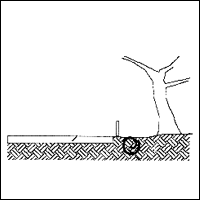  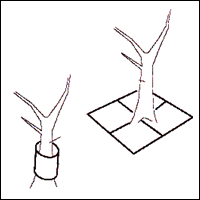  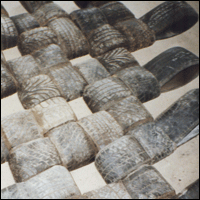
Ditch filled with rubber-netting roll.  Tree and root protecting mat Tree and root protecting mat  This tire mat, produced in a spezial This tire mat, produced in a spezial
The drainage function is unimpaired. interweaving way, helps taking roots interweaving way, helps taking roots
 on areas being very endangered by on areas being very endangered by
 erosion; it’s an efficient means to erosion; it’s an efficient means to
 reforestation in barren and rocky regions. reforestation in barren and rocky regions.
 The interwoven material keeps the The interwoven material keeps the
 substratum/mycelium, the seedlings and substratum/mycelium, the seedlings and
 the humidity. the humidity.
With road construction the tire mat protects buildings against mechanical action or serves as crossing protection,
e.g. for track vehicles. It can also serve as a temporary road over swampy and sandy substratum and it can lay a
level surface as it adapts to the relief. Furthermore the tire mat can be laid very easy, keeps stocks clean and dry
(top and bottom), reduces the frost risks used as cover material during the work on foundations of buildings, helps
to decouple the structure-borne noise (e.g. quarries, earthquakes) and can be used for the construction of slopes
or to fill depressions.
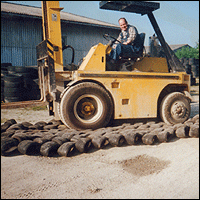  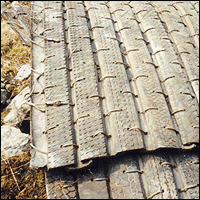
Crossing protection
Kurt Heidemann (limited partner) said: „If 10% of all tires, that come up only in Germany per year, would be used
i.e. for diking a river, provided that a mat of 50 m width is used for one dam, only a short distance of 6 km could be
built with this huge pile of tires.
Hydraulic engeneering
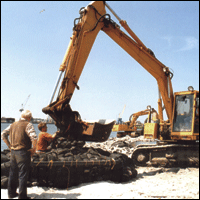  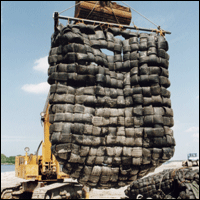  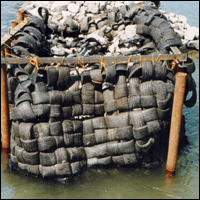
1998 in the harbour of Rostock-Warne- Interwoven bodies like these can also Interwoven bodies like these can also The independent dividing dam made of The independent dividing dam made of
münde this three-dimensional rubber- be produced comb-formed. Filled with be produced comb-formed. Filled with the three-dimensional rubber-mesh is filled the three-dimensional rubber-mesh is filled
mesh was installed as a dividing dam. stones, loam and sand they are bulwarks stones, loam and sand they are bulwarks with several tons of stones and it prevents with several tons of stones and it prevents
Building owner is the Water- and Ship- against extreme force effects, e.g. flood, against extreme force effects, e.g. flood, erosions in the underwater- and bank-area. erosions in the underwater- and bank-area.
ping Department in Stralsund. avalanches of mud, stones or snow. avalanches of mud, stones or snow.
 (l=2 m x w=2 m x d=5 m) (l=2 m x w=2 m x d=5 m)
Redevelopment of heaps
•
To green up kali heaps is a big ecopolitical problem. As the resulting costs seem to be very high for the present,
 for realization the interests of several institutions should be bundled based on synergy effects. for realization the interests of several institutions should be bundled based on synergy effects.
• Same goes with the eliminitation of old neglected deposites and construction secondary damage.
Disaster prevention, emergency roads
• The safe attainability of dams and buildings in case of an emergency is a long-term solvable problem, as the
 flood at the rivers Oder and Elbe has shown. flood at the rivers Oder and Elbe has shown.
Further possibilities of deployment for interwoven material in projects are such as:
•
shore protection
• harbor basins
• covers for wrecks
• oil-barriers
• canal-linings
For all projects preperatory work has to be done and we assess, that especially the hydraulic engeneering
projects show good promises for business.
|
|